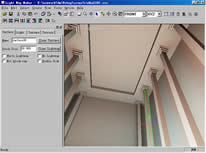| Make BestShareware.net your home page | Add BestShareware.net to your favorites |
 Homepage |
 Help Desk |
 Site Map |
 |
 Popular |
 What's New |
 Featured |
| MAC Software | Linux Software | Pocket PC | Free Games |
|
Light Map Maker - creates lighting effects Light Map Maker is a powerful tool for real-time 3D developers, it's main feature is adding
realistic lighting to real-time 3D scenes. It's robust lighting utility support ray tracing lighting,
realistic radiosity lighting, and caustics, mirror...
Light Map Maker can creates compelling lighting effects quickly.
Although easy and simple it is a fully professional application for game and simulation creation.
By using it, you can easily achieve professional lighting in real-time 3D scenes.
It also has geometry processing and light map tailoring (finding disorganized triangles to surfaces).
This ability is especially useful for those scenes modeled with the standard 3D programs (3dsmax, maya, etc).
The resultant lighting data can be directly saved to BMP or Radiance files, or outputted to custom format file
through Export-Plugins. So read this following manual and get to the fun fastest.
Light Map Maker is a powerful tool for real-time 3D developers, it's main feature is adding
realistic lighting to real-time 3D scenes. It's robust lighting utility support ray tracing lighting,
realistic radiosity lighting, and caustics, mirror...
Light Map Maker can creates compelling lighting effects quickly.
Although easy and simple it is a fully professional application for game and simulation creation.
By using it, you can easily achieve professional lighting in real-time 3D scenes.
It also has geometry processing and light map tailoring (finding disorganized triangles to surfaces).
This ability is especially useful for those scenes modeled with the standard 3D programs (3dsmax, maya, etc).
The resultant lighting data can be directly saved to BMP or Radiance files, or outputted to custom format file
through Export-Plugins. So read this following manual and get to the fun fastest.Light Map Maker provides a SDK(c++) for importing/exporting various data; now supports some popular 3D formats; so it's compatible with most game development software.
This section introduces some of the concepts that Light Map Maker uses to describe 3d components. Vertex: A vertex is a single point in 3d space. It's specified by three coordinates x, y and z. Triangle: A basic unit, composed of a mesh, determined by three vertices. Mesh: A triangle list. Surface: A series of connected triangles; all triangles in one plane. You can consider it a special mesh. Terrain: A Mesh, but unlike Surface, not requiring all triangles to be coplanar. Terrain is used to represent outdoor scenes because usually the area of triangles is much greater in outdoor scenes, so the lighting for "Terrain" is not base surface, but vertices. This reduces the file size of the lighting data. Mobile: A Mesh for those movable objects in scenes. Mobile can has it's Material. You not need (couldn't) calculating mobile's lighting, because it's lighting is realtime. Mobile is a helper for casting shadow, radiosity bake and caustics. Material: Materials describe how polygons reflect light or appear to emit light in a 3-D scene. Essentially, a material is a set of properties that explain the following things about the polygons it is rendering. 1. How they reflect ambient and diffuse light 2. What their specular highlights look like 3. Whether the polygons appear to emit light Light: Lights are used to illuminate objects in a scene. The current version of Light Map Maker employs three types of lights: point lights, spotlights, and directional lights. Point Lights: Point lights have color and position within a scene, but no single direction. They radiate light equally in all directions. Point Lights are also sometimes called omni lights. A light bulb is a good example of a point light. Point lights are affected by attenuation and range. Attenuation controls how a light's intensity decreases toward the maximum distance specified by the range property. Light Map Maker applies the following formula to calculate light attenuation over distance for point lights and spotlights (directional lights don't attenuate). 
In this attenuation formula, A is the calculated total attenuation and D is the distance from the light source to the sample point. Attenuation0, Attenuation1, and Attenuation2 values are the light's attenuation constants. Spotlights: Spotlights have color, position, and a direction in which they emit light. Light emitted from a spotlight is made up of a bright inner cone and a larger outer cone, with the light intensity diminishing between the two. A flashlight is a example of a spot light. Spotlights are affected by falloff, attenuation, and range. The light parameter Theta controls the inner cone, Phi controls outer cone, and Falloff controls the light intensity graduations from inner cone edge to outer cone. Directional Lights: Directional lights have only color and direction, not position, are not affected by attenuation or range. They emit parallel light. This means that all light generated by directional lights travels through a scene in the same direction. Imagine a directional light as a light source at near infinite distance, such as the sun. Light Map: A light map is a texture or group of textures that contains information about lighting in a 3D scene. Patch Size: Describes sample space of lighting calculation on surface. Smaller patch sizes carry more detailed lighting, but increase light map size. Mirror: A surface that has Reflection property
|
||||||||||||||||||||||||||||||||||||||||||||||||||
|
Submit Software |
Privacy Policy |
Terms of Use |
Advertise with Us |
Contact Us
Copyright ©  BestShareware.net. All rights reserved. BestShareware.net. All rights reserved.
|

